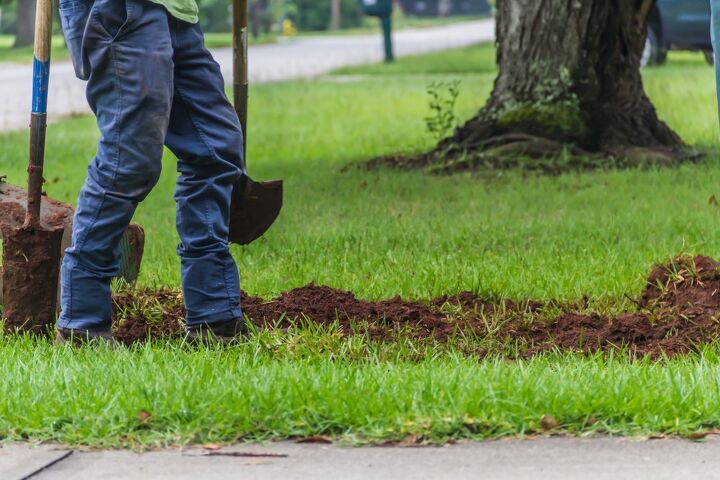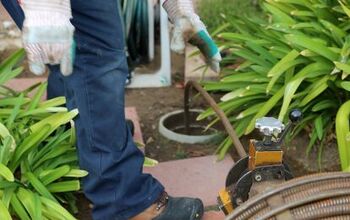How Long Does It Take For The Ground To Settle After Sewer Work?

After expensive sewer repairs that may have set you back a few grand, the last thing you may want to be looking at in your front yard is a massive mound of dirt where your pristine lawn once was. You may have saved your home from flooding by fixing your sewer line in time, but how long it will take for this ground to settle back into place?
While it can take up to 7 years for soil to settle naturally, expert plumbers can backfill the ground strategically to speed up this process. Using a ground tamper and soaking the area with water can help to level out this mound in your yard. With proper attention, your ground can settle into place in less than a year after sewer work.
We will let you in on why you have this mound in your yard after sewer work, and how you can speed up the settling process.
Do You Need Minor Grading or Resloping Services?
Get free, zero-commitment quotes from pro contractors near you.

Why You May Have a Mound of Dirt after Sewer Work
Ever wondered why you can dig up a hole, and then have excess soil when you fill that hole back in? Well, it has to do with soil composition. Soil is composed of minerals, water, and organic matter. Over time, it settles into place and the tiny air pockets disappear. However, when soil is disturbed, the pockets of air and water between the soil particles become larger again. This is can lead to a mound of displaced dirt where you previously had a level surface.
Some other reasons you have extra dirt on your hand may be because the new pipes are larger in size than your previous sewer line. Also, many companies put a layer of gravel under the pipe to avoid settling and “bellied pipe.” They will usually leave just enough dirt in the mound so that in a few months’ time you will have a level (and not sunken) lawn.
When Can I Expect to See the Ground Settle Back Into Place?
In most cases, it will take several months for the soil to settle back into place after sewer work. Expert plumbers can finish the backfilling process strategically for ideal settling. They will usually take away excess dirt and use a mechanical tamper to compact the ground to make sure that in a few months you will have an even lawn.
It may be worth working with a more expensive company if they can also ensure ideal groundwork after they repair your sewer work. You may want to discuss this detail with your plumbing company before you hire.
When the plumbers finish their work, you may have 1 or more feet of dirt mounded on top of your new sewer line. It is not a good idea to shovel down the mound before talking to the company about it. You could end up with a sunken spot in your yard in a few months. However, there are some things you can do to help this mound disappear faster.
How to Help Your Ground Settle Faster
If your yard is your pride and joy, you may want to do anything possible to get your beautiful landscape back as soon as possible. Unfortunately, there is no miracle cure, but there are a few ways to speed up the waiting process by taking action. Here are a few steps to help your ground settle:
Step 1: Aerate the soil
The first step will be to poke holes in your mound so that the water you pour over will have a chance to enter. You can do this with a core aerator, which is specifically designed to remove plugs of ground. This machine is a push machine like a lawnmower, but instead of cutting grass, this machine will poke evenly spaced holes in the affected area. You can also poke holes manually into the soil.
Step 2: Rake the surface
Using a bow rake, you will want to rake the soil to have a flat surface. You can even smooth the area with the back of the rake. If you are planning to plant this area, you can use this opportunity to also clear the ground of rocks, sticks, and debris.
Step 3: Water your mound
Water is one of the most helpful tools to compact your soil back in place. Generally, slow and steady water pressure will be more effective than a high-powered blast. You will want to use a water hose with a diffusing spray nozzle and wet the entire area. When you see the water pooling on the surface, you will know the area is well-saturated. As the water fills in your holes, the ground will begin to compact.
Step 5: Tamp the ground
Tamp your ground using a hand tamper or a lawn roller to further compact your soil.
Step 6: Use a soaker hose
After following these steps, you can continue to speed up the compaction process by running a soaker hose over your mound regularly. This slow watering process will help your soil find its place!
Do You Need Minor Grading or Resloping Services?
Get free, zero-commitment quotes from pro contractors near you.

Related Questions
What are the signs of a sewer line problem?
It’s hard to know what’s going on under the ground without seeing it for yourself. However, your sewer lines will leave some signs. A smelly drain, sinkholes in your yard, or a slow-flushing toilet, can be signs that your sewer line needs some attention.
What are the most common problems to affect a sewer line?
Tree roots and shifting (or frozen) soil can affect your sewer line. These are some of the most common reasons that your sewer line can break, crack, or collapse. Also, if your pipe is older than 50 years, it may be reaching the end of its lifespan. Most sewer lines can last from 50 to 100 years.
What type of sewer line has the shortest lifespan?
Orangeburg pipes are one of the least resistant types of sewer lines. They can last up to 50 years, but generally show signs of aging after 30 years. Orangeburg pipes were essentially made out of asphalt and wood pulp. Many homes used Orangeburg pipes for plumbing beginning in 1945. Orangeburg pipes continued to be used in buildings until 1972 when the Orangeburg plant closed.

Alex Praytor is a native Texan who got her degree in English Literature and decided to travel the globe. She finds the architecture and design of homes across cultures fascinating. In her spare time, she visits coffee shops with her family and creates projects for their own home. Alex enjoys sharing tips on how to keep repairs up to date while turning a house into a home.
More by Alex Praytor













![The 5 Best Angle Grinders – [2022 Reviews & Buyer's Guide]](https://cdn-fastly.upgradedhome.com/media/2023/07/31/9071326/the-5-best-angle-grinders-2022-reviews-buyer-s-guide.jpg?size=350x220)





![10 Most Dangerous Neighborhoods in Baltimore [Updated]](https://cdn-fastly.upgradedhome.com/media/2023/07/31/9075655/10-most-dangerous-neighborhoods-in-baltimore-updated.jpg?size=350x220)
![Standard Dining Room Table Dimensions [for 4, 6, 8, 10 and 12 People]](https://cdn-fastly.upgradedhome.com/media/2023/07/31/9074335/standard-dining-room-table-dimensions-for-4-6-8-10-and-12-people.jpg?size=350x220)






